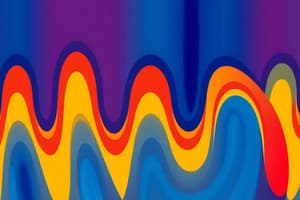Podcast
Questions and Answers
What does the unit Hz specifically measure?
What does the unit Hz specifically measure?
- Speed of a wave
- Distance travelled by a wave
- Number of cycles per second (correct)
- Time taken for one complete oscillation
What is the formula relating wave speed, frequency, and wavelength?
What is the formula relating wave speed, frequency, and wavelength?
- v = f - λ
- v = f + λ
- v = f × λ (correct)
- v = λ / f
Which of the following describes longitudinal waves?
Which of the following describes longitudinal waves?
- Particles remain stationary
- Particles move parallel to the direction of wave travel (correct)
- Particles move in a circular motion
- Particles move perpendicular to the direction of wave travel
Which is NOT a behavior of waves?
Which is NOT a behavior of waves?
What is the relationship between time period (T) and frequency (f)?
What is the relationship between time period (T) and frequency (f)?
How is the speed of sound generally measured?
How is the speed of sound generally measured?
What is meant by the term amplitude in the context of waves?
What is meant by the term amplitude in the context of waves?
What frequency range can humans hear?
What frequency range can humans hear?
What does the X-axis on a Cathode Ray Oscilloscope (CRO) represent?
What does the X-axis on a Cathode Ray Oscilloscope (CRO) represent?
How is the amplitude of a waveform on a CRO determined?
How is the amplitude of a waveform on a CRO determined?
What happens when you adjust the time base knob to a larger value on the CRO?
What happens when you adjust the time base knob to a larger value on the CRO?
What is the relationship between frequency (f) and time period (T)?
What is the relationship between frequency (f) and time period (T)?
When measuring wavelength on a CRO, what should you do?
When measuring wavelength on a CRO, what should you do?
Which knob would you use to compress or stretch the waveform vertically on the CRO?
Which knob would you use to compress or stretch the waveform vertically on the CRO?
What does the trigger function do on a CRO?
What does the trigger function do on a CRO?
If the gain is set to 5 mV/div and the wave spans 3 divisions, what is the amplitude?
If the gain is set to 5 mV/div and the wave spans 3 divisions, what is the amplitude?
How do you calculate the frequency of a wave if the time period is measured as 4 ms?
How do you calculate the frequency of a wave if the time period is measured as 4 ms?
In terms of wave properties, what does diffraction refer to?
In terms of wave properties, what does diffraction refer to?
What prefix represents one million in wave measurements?
What prefix represents one million in wave measurements?
Which of the following statements about reading a CRO is true?
Which of the following statements about reading a CRO is true?
What is indicated by the vertical divisions on a CRO?
What is indicated by the vertical divisions on a CRO?
What is the typical function of the cursor feature on modern oscilloscopes?
What is the typical function of the cursor feature on modern oscilloscopes?
If the wave period spans 6 divisions and the time base is set to 1 ms/div, what is the time period?
If the wave period spans 6 divisions and the time base is set to 1 ms/div, what is the time period?
Flashcards
Frequency
Frequency
The number of oscillations (complete back-and-forth movements) that occur in one second.
Wavelength
Wavelength
The distance between two consecutive crests (highest points) or troughs (lowest points) in a wave.
Wave Speed
Wave Speed
The speed at which a wave travels through a medium, measured in meters per second (m/s).
Energy Propagation
Energy Propagation
Signup and view all the flashcards
Medium
Medium
Signup and view all the flashcards
Amplitude (of a wave)
Amplitude (of a wave)
Signup and view all the flashcards
Time Period (of a wave)
Time Period (of a wave)
Signup and view all the flashcards
Transverse Wave
Transverse Wave
Signup and view all the flashcards
Waveform Display
Waveform Display
Signup and view all the flashcards
Reflection
Reflection
Signup and view all the flashcards
Refraction
Refraction
Signup and view all the flashcards
Diffraction
Diffraction
Signup and view all the flashcards
X-axis (Time Axis)
X-axis (Time Axis)
Signup and view all the flashcards
Y-axis (Voltage Axis)
Y-axis (Voltage Axis)
Signup and view all the flashcards
Time Base
Time Base
Signup and view all the flashcards
Voltage Scale
Voltage Scale
Signup and view all the flashcards
Time Period
Time Period
Signup and view all the flashcards
Amplitude
Amplitude
Signup and view all the flashcards
Cursor Function
Cursor Function
Signup and view all the flashcards
Trigger Function
Trigger Function
Signup and view all the flashcards
Trigger Level
Trigger Level
Signup and view all the flashcards
Study Notes
SI Units
- Hertz (Hz): Unit of frequency, cycles per second
- Meters (m): Unit of distance, wavelength
- Seconds (s): Unit of time
- Meters per second (m/s): Unit of speed, wave speed
Terminology and Definitions
- Oscillations: Repeated back-and-forth motion
- Vibrations: Rapid particle movements in a medium
- Frequency: Number of oscillations per second (Hz)
- Wavelength: Distance between consecutive crests/troughs
- Speed: Wave travel rate (m/s)
- Energy Propagation: Movement of energy as waves through a medium
- Medium: Material through which a wave travels (e.g., air, water)
- Amplitude: Maximum displacement of particles from rest, related to wave height
- Time Period: Time for one complete oscillation (s)
Wave Types
Transverse Waves
- Particle motion: Perpendicular to energy propagation (e.g., up and down)
- Examples: Light, water, string waves
Longitudinal Waves
- Particle motion: Parallel to energy propagation (e.g., back and forth)
- Examples: Sound, shock, pressure waves
Wave Equation
- Wave speed (v) = Frequency (f) × Wavelength (λ)
- Formula: v = fλ
Time Period/Frequency
- Time period (T): Time for one oscillation
- Formula: T = 1/f
- Frequency (f): Oscillations per second
- Formula: f = 1/T
Wave Behavior
- Reflection: Wave bouncing off a surface
- Refraction: Wave changing direction due to speed change in a new medium
- Diffraction: Wave spreading around obstacles or through gaps
Sound
- Production/Transmission: Sound produced by vibrating objects, travels through a medium
- Speed of Sound: Speed = Distance/Time
- Practical measure: Use two microphones to measure sound speed.
- Human Hearing Range: 20 Hz to 20,000 Hz
- Noise: Unwanted or unpleasant sound
Cathode Ray Oscilloscope (CRO)
- Measuring Time Period: Use time base setting to measure time for one complete oscillation
- Calculating Frequency: f = 1/T
- Waveform Display: Shows waveforms of sound sources (e.g., music)
Ripple Tank Waves
- Reflection: Waves bouncing off barriers
- Refraction: Waves changing direction in different media
- Diffraction: Waves spreading around objects or through gaps
Reading a CRO
Understanding the Display
- Horizontal axis (X-axis): Time (ms or µs/div)
- Vertical axis (Y-axis): Voltage (V/div)
Adjusting Time Base & Voltage
- Time base (Time/Div knob): Controls how fast signal moves; higher = faster; lower = slower
- Voltage scale (Volts/Div knob): Controls signal height; higher = compressed; lower = stretched
Reading the Signal
- Frequency: Calculate from time period. (f = 1/T) Example: 2 ms /Cycle --> 500 Hz.
- Amplitude: Vertical distance from baseline to peak/trough. Example: 4 divisions x 2V/division --> 8V
- Wavelength: Horizontal distance between peaks/troughs.
Using Cursors
- Modern CROs have cursor functions to provide direct measurements.
Triggering
- Trigger function: Synchronizes waveform display – adjust trigger level and slope to get a stable waveform.
Summary of Formulas and Concepts
- Time Period (T): Horizontal length of one cycle
- Frequency (f): 1 / Time Period (T)
- Amplitude: Vertical distance from baseline to peak/trough
- Wavelength: Measured along the X-axis for one full cycle.
- Wave speed (v): f x λ
- Time Period/Frequency formulas (T = 1/f and f = 1/T)
Determining Wave Characteristics from a CRO
-
Amplitude:
- Look at the vertical scale (Y-axis), which shows mV/div or V/div.
- Count the vertical divisions from baseline to peak (or trough).
- Multiply the number of divisions by the gain to get the amplitude. (Amplitude = divisions x gain in mV/div or V/div)
-
Time Period:
- Check horizontal scale (X-axis) with either ms/div or s/div marking.
- Count the horizontal divisions from one peak to the next peak (or trough to trough) representing one cycle.
- Calculate the time period: (Time Period = divisions x time base in ms/div or s/div)
-
Frequency:
- Calculate from knowing the time period: (f = 1 / Time Period).
Standard Prefixes
- Prefixes to express very large or small numbers (important for GCSE):
- nano (n): 10-9
- micro (µ): 10-6
- milli (m): 10-3
- kilo (k): 103
- mega (M): 106
- giga (G): 109
Studying That Suits You
Use AI to generate personalized quizzes and flashcards to suit your learning preferences.



